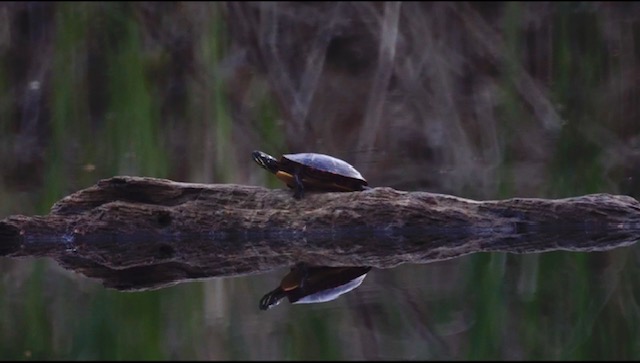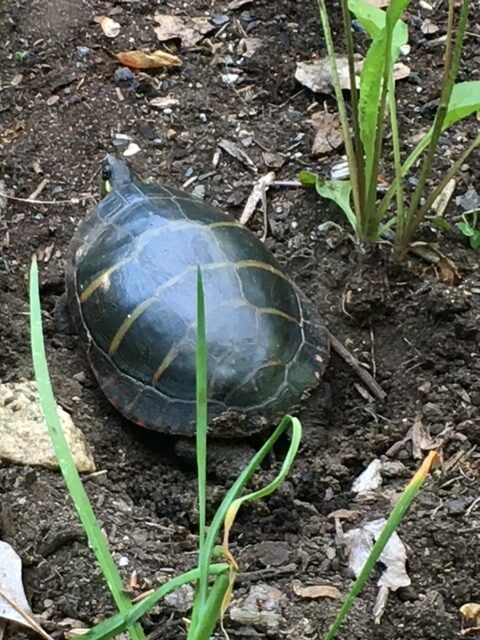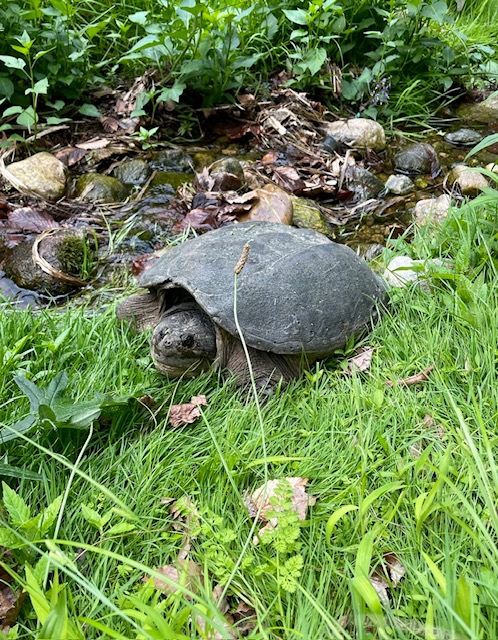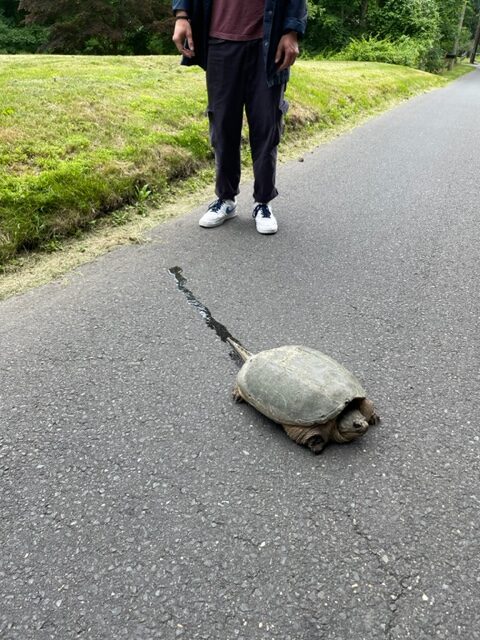
Eastern painted turtle basking on a log at Still Pond Preserve. Photo by Connor deMayo.
Did you know that the United States has more species of turtles than any other country? According to CT’s Department of Energy and Environmental Protection, there are 328 species of turtles worldwide. Fifty-seven of these species (about 20% of all turtle species) are found in the United States and Canada. Connecticut hosts 12 species, including 4
kinds of sea turtles. Nine of the 12 are listed as endangered, threatened, or of special concern.
The 3 most common turtles found in New Canaan, and especially on our Land Trust preserves, are: eastern painted, snapping, and box turtles. The first two are pond dwellers, while the latter are terrestrial. All turtles lay their eggs on dry land and will sometimes travel quite far to search for the best nesting site.
Eastern Painted Turtle

This female chose to lay her eggs in the newly planted Silvermine-Fowler meadow a few years ago. Photo by Susan Bergen.
Eastern painted turtles are Connecticut’s most abundant turtle species. They inhabit slow-moving fresh water such as ponds, lakes, bogs, and wetlands. They bask in the sun to warm up and are often seen lining up on logs or rocks. The females come ashore in late May and early June to lay eggs. Their chosen nest site can be steps from the water or a half mile away. They dig a shallow hole, lay 5 to 6 eggs on average, cover them with soil, and leave them to develop on their own.
Turtle eggs and hatchlings are vulnerable to predation by raccoons, skunks, possums, weasels, otters, minks, foxes, coyotes, and birds. Turtles who survive to adulthood are protected by their hard shells. Eastern painted turtles don’t reach sexual maturity until age ten and can live as long as 40 years. Their diet consists of aquatic vegetation, insects, crustaceans and fish.
Eastern Box Turtles

A female Box Turtle with brown eyes; the males have red ones. Photo by Susan Bergen.

The yellow patterns on the shell are unique to each individual box turtle. Board member Tom Reynolds has photographed this same turtle two years in a row at Watson-Symington Preserve.
The eastern box turtle is rated as a species of special concern in Connecticut. Their habitat includes woodlands with dense undergrowth, wetland areas, bogs, and damp meadows. In summer, they are active in the morning and evening and shelter mid-day in mud or damp vegetation to escape the heat. They spend the winter in hibernation, buried in the soil or under a cover of insulating leaf mulch.
Young box turtles are generally carnivorous and hunt in water, while adults feed on land. Their diet varies from berries, roots, and flowers to insects, eggs, and amphibians. Box turtles keep to a small home range of between 2 and 10 acres. As they usually hibernate in the same spot each winter, they are vulnerable to changes in the landscape. These alterations can be as simple as converting a patch of natural undergrowth into a lawn or erecting a fence that can cut their territory in half and prevent them from finding mates. Female box turtles can store sperm up to 4 years, so they don’t need to mate yearly! Their lifespan runs from 50 to 100 years.
Common Snapping Turtles

Photo by Tom Reynolds
Common snapping turtles are the largest freshwater turtle in Connecticut. As they are highly adaptable, their populations remain high. They are mainly aquatic and tend to live in larger bodies of water such as ponds and lakes. The females come on land between May and July, lay their eggs, and will travel far (even up to a mile away) to find a perfect nesting site. They can lay anywhere between 10 to 60 eggs, with 35 being the average number. Larger females lay more eggs. Their eggs and hatchlings are subject to predation from various animals, birds, and snakes. As adults, they are pretty formidable, with strong jaws and claws. Once they mature around age 10, they can live another 30 years.
Adult snappers are omnivores with a wide diet of plant leaves, fruits and berries, fungi, insects, crayfish, fish, frogs, and snakes. They will go after baby ducks and geese and small mammals.
Turtle Conservation

While painted and box turtles can be picked up and moved easily, it is best not to handle snappers. Photo by Tom Reynolds.
Under the right conditions, turtles in the wild can survive a long time. However, they are challenged by land and water pollution, disappearing natural areas, and habitat fragmentation. They need connected green corridors to move about safely, searching for mates, nesting sites, and hibernation spots. We can help by preserving sanctuaries of wild lands throughout our community and maintaining some wild space in our own landscapes.
We can also help by being mindful of turtles crossing the road. Traffic is one of the biggest threats to turtles in suburbia. While turtles may appear “to be lost” when crossing the road, they know exactly which direction they are going. The best way to help is to move them to the shoulder where they are headed. Otherwise, they will turn around and cross the road again.
As a species, turtles are believed to be older than the dinosaurs. They are interesting creatures and enrich the diversity of our natural habitats. With our vigilance they will continue to survive and thrive.
Love hearing about turtles.